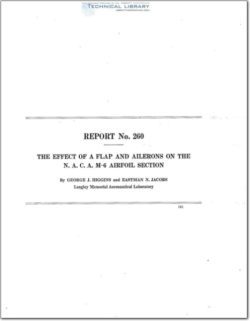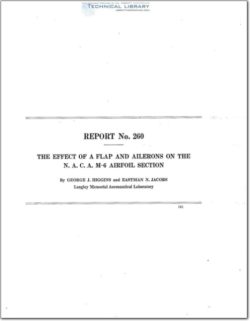naca-report-260

- Version
- 168 Downloads
- 1.27 MB File Size
- 1 File Count
- April 21, 2016 Create Date
- April 21, 2016 Last Updated
National Advisory Committee for Aeronautics, Report - The Effect of a Flap and Ailerons on the NACA M6 Airfoil Section

This report contains the results obtained at the Langley Memorial Aeronautical Laboratory
on an N. A. 0. A. Iii—6‘ airfoil, fitted with a flap and ailerons, and tested in the rariahle density
wind tunnel at a density of 20 atmospheres. Airj’oil characteristics are given for the model up to
48° angle of attach with the fin p set at various angles, and also with the ailerons set at similar angles.
The approximate lift distribution and the center of pressure variation along the span are determined
with the model at 18° angleof attach: and with the ailerons displaced 20°. Approximate rolling
moment and yawing moment coefficients are determined for the carious aileron settings.
A comparison of the calculated angles of zero lift and the calculated lift and moment coefiicients
with those observed is given in the appendix.
The N. A. C. A. M—S is a good airfoil section, stable in pitch and With very small center of
pressure travel. Consequently in its adoption in airplane design, some knowledge of its
behavior under the action of ailerons or of a flap seems desirable. This is particularly true
in regard to the center of pressure travel. As no similar tests have been conducted under
full—scale conditions, this series was undertaken by the Aerodynamics Stafi of the Langley
Memorial Aeronautical Laboratory in their variable density Wind tunnel. To obtain, at the
same time, the cheat of controls; that is, flap or ailerons, at high angles, the range of investiga- ,
tion was made to extend from zero lift to an angle of attack of +48°.
The model was a 6-inch by 36-inch duralumin airfoil of the N. A. C. A. M—6 section. A
flap and two ailerons were constructed along the trailing edge, see Figures 1 to 4. The ailerons
W ere one- quarter span each 1n length; and the flap consist-ed of the remaining portion of the
trailing edge between the ailerons. In the tests with the flap, the ailerons were set‘in line as
if integral with the flap. In the aileron tests, the flap was set neutral and the ailerons were set
both up or both down. Consequently, in these latter tests, the balance readings were approxi-
mately equivalent to double those for a semispan.
| File | Action |
|---|---|
| naca-report-260 The Effect of a Flap and Ailerons on the NACA M6 Airfoil Section.pdf | Download |
Comment On This Post